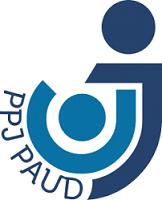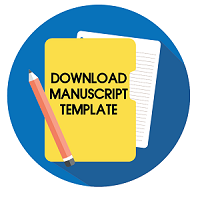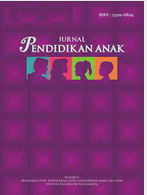Permainan literasi untuk anak-anak
Abstract
Keywords
Full Text:
PDFReferences
Borisova, I., Pisani, L., Dowd, A. J., & Lin, H.-C. (2017). Effective interventions to strengthen early language and literacy skills in low-income countries: comparison of a family-focused approach and a pre-primary programme in Ethiopia. Early Child Development and Care, 187(3–4), 655–671. https://doi.org/10.1080/03004430.2016.1255607
Catts, H. W., Fey, M. E., Zhang, X., & Tomblin, J. B. (2001). Estimating the risk of future reading difficulties in kindergarten children: A research-based model and its clinical implementation. Language, Speech, and Hearing Services in Schools, 32(1), 38–50. https://doi.org/10.1044/0161-1461(2001/004)
Cocks, A. J. (2006). The ethical maze: Finding an inclusive path towards gaining children’s agreement to research participation. Childhood, 13(2), 247–266. https://doi.org/10.1177/0907568206062942
Copp, S. B., Cabell, S. Q., & Tortorelli, L. S. (2016). See, Say, Write: A Writing Routine for the Preschool Classroom. Reading Teacher, 69(4), 447–451. https://doi.org/10.1002/trtr.1419
Cummings, K. D., Kaminski, R. A., Good, R. H., & O’Neil, M. (2011). Assessing phonemic awareness in preschool and kindergarten: Development and initial validation of First Sound Fluency. Assessment for Effective Intervention, 36(2), 94–106. https://doi.org/10.1177/1534508410392209
Dodd, B. (2016). Young children’s letter-sound knowledge. American Journal of Speech-Language Pathology, 34(1), 128–137. https://doi.org/10.1044/0161-1461(2003/011)
Domville, M. S., Watson, P. M., Richardson, D. J., & Graves, L. E. F. (2018). Educator perspectives on factors influencing children’s school-based physical activity. Health Promotion International, 34(5), 1–10. https://doi.org/10.1093/heapro/day041
Edmiston, B. (2008). Forming Ethical Identities in Early Childhood Play (Vol. 9, Issue 1). https://doi.org/https://doi.org/10.1177%2F14687984090090010502
Farley, K. S., & Piasta, S. B. (2020). Examining early childhood language and literacy learning opportunities in relation to maternal education and children’s initial skills. Journal of Education for Students Placed at Risk (JESPAR), 25(3), 183–200. https://doi.org/10.1080/10824669.2019.1689506
Fawcett, A. J., & Lynch, L. (2000). Systematic Identification and Intervention for Reading Difficulty: Case Studies of Children with EAL. Dyslexia, 6, 57–71. https://doi.org/https://doi.org/10.1002/(sici)1099-0909(200001/03)6:1%3C57::aid-dys163%3E3.0.co;2-w
Gagné, R. M., & White, R. T. (1978). Memory Structures and Learning Outcomes. Review of Educational Research, 48(2), 187–222. https://doi.org/10.3102/00346543048002187
Goodrich, J. M., Lonigan, C. J., & Farver, J. A. M. (2017). Impacts of a literacy-focused preschool curriculum on the early literacy skills of language-minority children. Early Childhood Research Quarterly, 40, 13–24. https://doi.org/10.1016/j.ecresq.2017.02.001
Gove, A., & Wetterberg, A. (2011). The Early Grade Reading Assessment: Applications and interventions to improve basic literacy. In The Early Grade Reading Assessment: Applications and Interventions. http://www.rti.org/pubs/bk-0007-1109-wetterberg.pdf
Hassett, D. D. (2006). Signs of the times: The governance of alphabetic print over appropriate and natural reading development. Journal of Early Childhood Literacy, 6(1), 77–103. https://doi.org/10.1177/1468798406062176
Justice, L. M., Invernizzi, M. A., & Meier, J. D. (2002). Designing and implementing an early literacy screening protocol: Suggestions for the speech-language pathologist. Language, Speech, and Hearing Services in Schools, 33(2), 84–101. https://doi.org/10.1044/0161-1461(2002/007)
Mctaggart, R. (1991). Principles for participatory action research. Adult Education Quarterly, 41(3), 168–187. https://doi.org/10.1177/0001848191041003003
Mullis, I. V. S., Martin, M. O., Foy, P., & Drucker, K. T. (2012). PIRLS 2011 International Results in Reading. In TIMSS & PIRLS International Study Center. https://doi.org/10.1097/01.tp.0000399132.51747.71
Nassrallah, F., Fitzpatrick, E. M., Whittingham, J., Sun, H., Na, E., & Grandpierre, V. (2020). A descriptive study of language and literacy skills of early school-aged children with unilateral and mild to moderate bilateral hearing loss. Deafness & Education International, 22(1), 74–92. https://doi.org/10.1080/14643154.2018.1555119
OECD. (2007). PISA 2006, Science competencies for tomorrow’s world Volume1: Analysis. In OECD Publishing, (Vol. 30, Issue 1). OECD Publishing. https://doi.org/10.1787/9789264040014-en
OECD. (2010). PISA 2009 Results: What Students Know and Can Do. In PISA 2009 Results: What Students Know and Can Do: Vol. I. OECD Publishing. https://doi.org/10.1787/9789264188716-ar
OECD. (2013). A Profile of Student Performance in Reading. In What Students Know and Can Do: Student Performance in Mathematics, Reading, and Science-Volume I: Vol. I (pp. 175–214). OECD Publishing. https://www.oecd-ilibrary.org/docserver/9789264208780-8-en.pdf?expires=1592190520&id=id&accname=guest&checksum=5CEA1CEF3AE36FCEF64657B927BDC963
OECD. (2016). PISA 2015 Results Excellence and Equity in Education Volume I: Vol. I. OECD Publishing. https://doi.org/10.1787/9789264266490-5-en
OECD. (2018). PISA 2018 Released Field Trial New Reading Items. 2(January), 1–46.
Renz, S. M., Carrington, J. M., & Badger, T. A. (2018). Two Strategies for Qualitative Content Analysis: An Intramethod Approach to Triangulation. Qualitative Health Research, 28(5), 824–831. https://doi.org/10.1177/1049732317753586
Rogers, R., Labadie, M., & Pole, K. (2016). Balancing voice and protection in literacy studies with young children. Journal of Early Childhood Literacy, 16(1), 34–59. https://doi.org/10.1177/1468798414554632
Shrum, W., Duque, R., & Brown, T. (2005). Digital video as research practice: Methodology for the millennium. Journal of Research Practice, 1(1), 1–19.
Sternberg, R. J. (2006). The nature of creativity. Creativity Research Journal, 18(1), 87–98. https://doi.org/10.1207/s15326934crj1801_10
Vezzosi, M. (2006). Information literacy and action research: An overview and some reflections. New Library World, 107(7–8), 286–301. https://doi.org/10.1108/03074800610677272
Weigel, D. J., Martin, S. S., & Bennett, K. K. (2006). Mothers’ literacy beliefs: Connections with the home literacy environment and pre-school children’s literacy development. Journal of Early Childhood Literacy, 6(2), 191–211. https://doi.org/10.1177/1468798406066444
Werfel, K. L. (2017). Emergent literacy skills in preschool children with hearing loss who use spoken language: Initial findings from the Early Language and Literacy Acquisition (ELLA) study. Language, Speech, and Hearing Services in Schools, 48(4), 249–259. https://doi.org/10.1044/2017_LSHSS-17-0023
Witte, R. S., & Witte, J. S. (2017). Statistics Eleventh Edition (LCCN 20160). John Wiley & Sons, Inc.
DOI: https://doi.org/10.21831/jpa.v12i1.61137
Refbacks
- There are currently no refbacks.
Copyright (c) 2023 Jurnal Pendidikan Anak

This work is licensed under a Creative Commons Attribution-ShareAlike 4.0 International License.
Our Journal indexed by:
Supervised by:
Jurnal Pendidikan Anak is licensed under a Creative Commons Attribution-ShareAlike 4.0 International License.
Based on a work at https://journal.uny.ac.id/index.php/jpa.
Jurnal Pendidikan Anak Stats















